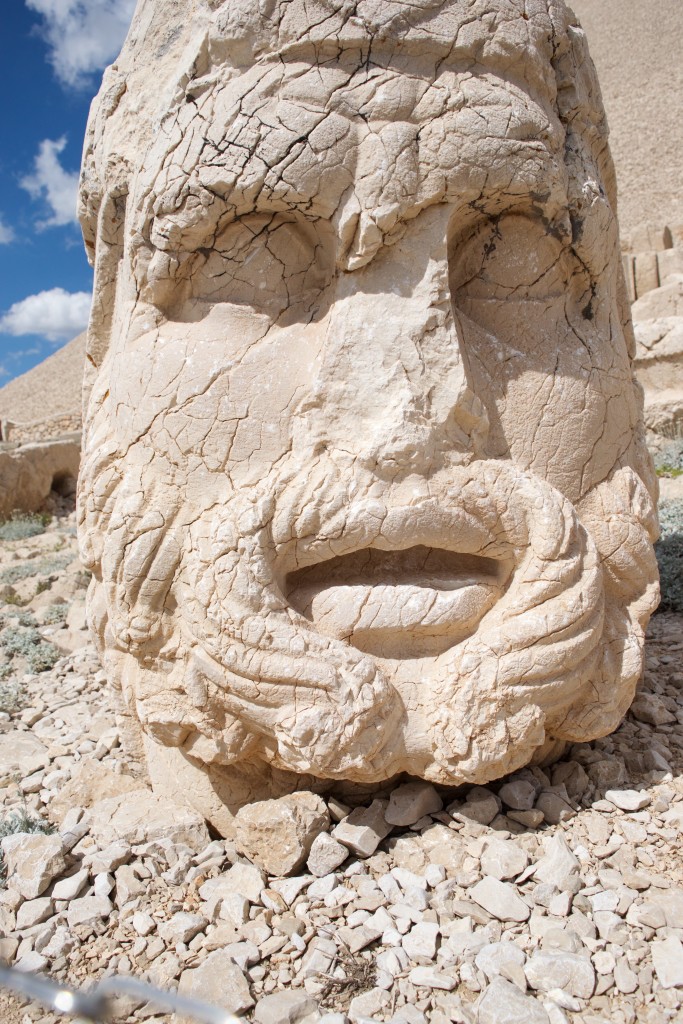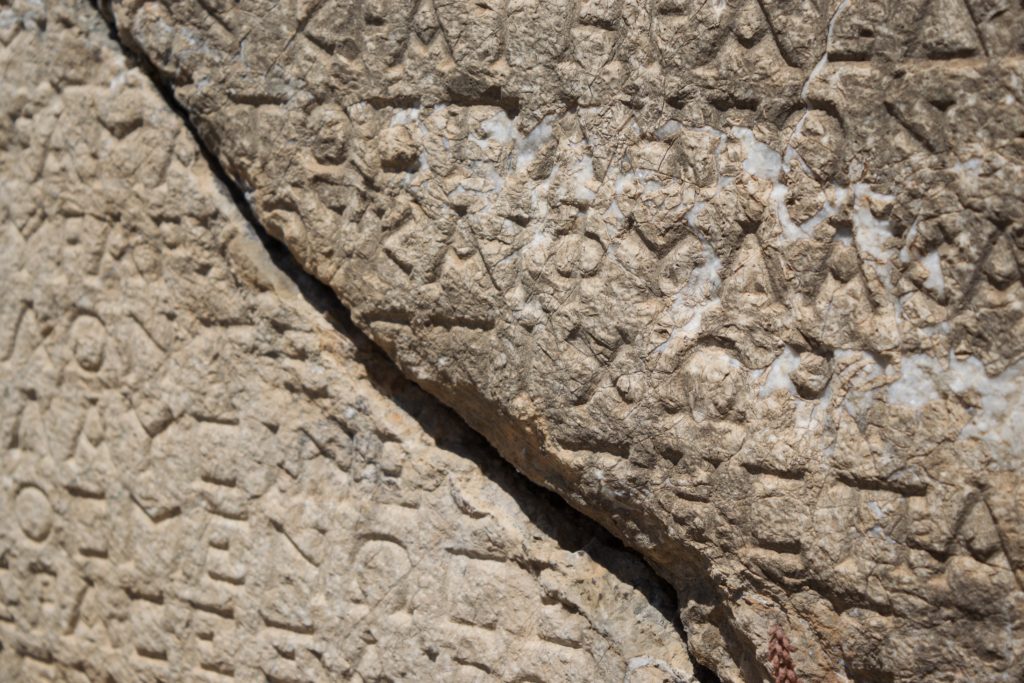Mount Nemrut is visible from every direction. From afar, it appears to be the highest promontory in this range of the Taurus Mountains. From a bit closer, a small, discolored smudge may be seen at its peak, though what it might be remains elusive. From its base, it reveals itself: a 50-meter tall and 150-meter wide tumulus of loose rock and disfigured statues, it is the funeral monument of the greatest, and perhaps the maddest, king of the Commagene Empire.
Antiochus I, a just, eminent god, friend of Romans and friend of Greeks (as his full title goes), was born July 16, 98 BCE, the son of Mithridates Callinicos of Commagene and Laodice VII Thea, a princess of the Seleucid Empire. Half Armenian and half Greek, Antiochus counted himself a descendant of the Persian King Darius I and all of Alexander the Great’s successor generals, Seleucus I Nicator, Ptolemy I, Antigonus I Monopthalmos, Lysimachus, and Antipater, a group known as the Diadochi. In both his name and his lineage, he was a figure that straddled the two greatest empires of Europe and Asia.
They were long gone by the time he sat his throne, however, and so his doubling act extended into his political life as well. At the confluence of two young, mighty, and expanding empires, Rome and Parthia, Antiochus walked a tightrope that saw him pledge fealty to Rome with one hand and give his daughter as a bride to the Parthian king with the other. His political expediency cost him in the end. When he deserted Rome in favor of Parthia during one of their wars, he was besieged at his capital city and later forced to pay a large war indemnity to the Senate. Cassius Dio recorded his murder at the hands of Phraates IV of Parthia, though whether it was for treachery or some more mundane purpose goes unsaid.
Despite his exploits, it is not the life of Antiochus I that intrigues people today, but his death. In the mountains between his twin capitals of Arsameia and Samosata he built his mausoleum, that monument to his vanity, that strange commingling of Greek and Asiatic forms. In every aspect of his rule, from the way he built his cities, to how he styled his name, to how he prepared his tomb, Antiochus I was a hybrid of two worlds that more often than not would wish to remain separate. His balancing act represents an astonishing success in the checkered history of multiculturalism. But, even deeper than that, he was nothing less than the apotheosis of Alexander the Great’s world-conquering dreams.

The head of Zeus. ©Matthew Strebe/Global Heritage Fund
North of Athens, just south of the wild land of Thrace, lived a people that had only recently been incorporated into the Greek world. To all proper Greeks, they were largely unworthy of the name. Their king Alexander I was the first to compete in the Olympics, but his Greek lineage was considered an affront and a fabrication, and though he marked himself as a descendant of heroes, his name appears nowhere in the list of victors. Even in the time of Philip II, the father of Alexander the Great, there was thinly veiled skepticism: according to Oxford classicist Robin Lane Fox, “the Greeks had seldom been convinced by these northerners’ insistence, and only to flatterers was Philip anything better than a foreign outsider.”
Despite their compatriots’ disdain, these Macedonians – goatherders, barbarians, and non-Greeks all – rose faster than even they could have dreamed. Between the reign of their king Philip II, who died in Greece, and their emperor Alexander the Great, who shook off his mortal coil amid his generals, children, wives, and concubines in the great Persian halls of Babylon, there was a cultural efflorescence whose likes the Greek world had never before seen.
Alexander the Great was called such because he conquered the known world. He remains such because his empire set in motion profound changes that reverberate today: to impose his world-shaping vision from the Mediterranean to the Indian Ocean, he worked to create unity, between religions, between systems of government, and between peoples, under the aegis of the god-king he would become, the Hellenic culture he adopted, and the world-straddling empire of Eurasia he created.
He envisioned a hybrid ruling class of Macedonians and Persians drawn from the noblest blood of both peoples. When he married the Bactrian princess Roxane and forced many of his subordinates and even his common soldiers to take Persian wives of their own, he took the first step away from the provincialism of Greece towards the universalism he hoped for. He founded a string of Alexandrias from Egypt to the Indus to diffuse Greek civilization, populated with the many hybrid families he made possible by decree. He ordered the youth of the Persian cities to be trained in the gymnasia of Greek culture. He killed those of his generals – Cleitus, Philotus, Parmenion, and Callisthenes – who opposed his dreams.

The Greek proclamation of citizenship at Arsameia. ©Matthew Strebe/Global Heritage Fund
Alexander the Dreamer, as this ideal is called, partakes equally of myth and history. It is often saturated with retrojections of latter-day liberal values, ones which Alexander clearly did not share. His was not to be a common weal, for everyone he conquered was subject to this Greek interloper, this King of Kings. Nor was it a more rarified dream of equality or universal brotherhood. And yet, his actions, though they were not animated by the nobility of spirit later ascribed them, nonetheless made possible – both in reality and in concept – the idea that such unity is actually attainable and worthy of being pursued.
Before Alexander, the concept of unity, or homonoia, described relations between Greek and Greek. All other peoples were barbaroi, barbarians, and unworthy even of humanity. After Alexander, homonoia is everywhere in art, literature, and politics: Alexarchus, brother to Alexander’s successor general Cassander, was wont to address his subjects as “Brethren”; the fragmentary work Eutopia conceived of the sky god Ouranos as the father, not just of the Greeks, but of all mankind; and so great was the influence of Alexander that before his bones were cold, the Aristotelian philosopher Theophrastus would write
Οὔτως δὲ καὶ τοὺς πάντας ἀνθρώπους ἀλλήλοις τίθεμεν οἰκείους καὶ συγγενεῖς
And so in this way, we place all men one to the other as of the same house and of the same family.
It is clear that his actions were interpreted in both world-conquering and world-uniting ways, and so while it may or may not have been his great dream to unite east and west, that is precisely what lived on in the Alexandrian successor states after he had died and his empire was divided between the Diadochi. Homonoia thus became the dream of Hellenism and the Hellenistic Age, and with it came the most extensive cultural exchange between east and west until the era of modern globalization.

Antiochus I shakes hands with Herakles, pictured here. ©Matthew Strebe/Global Heritage Fund
Homonoia is written clearly on these broken, chiseled faces. Carved from local stone and baked in the sun of the high mountains, removed from their bodies as the result of local iconoclasm, these colossal heads have survived as the eternal, unblinking sentinels of Mount Nemrut. Not only did they guard the souls of the Commagene kings, these statues fulfilled Alexander’s dream of a unity between the cultures of east and west.
They are immediately striking as both very familiar, yet very alien, the products of a regional syncretism that melded Zeus, Ahura Mazda, Tyche, Herakles, and other gods and goddesses of the Greek and Persian worlds. According to the Encyclopedia Iranica:
An inscription from Nimrud Dag (Dittenberger, Orientis Graeci inscriptiones selectae, I, 383, 1. 54f.) enumerates the deities of the dynastic pantheon. Following the dual tradition of the kingdom, the gods receive both Greek and Iranian names: Antiochus worships Zeus-Oromasdes, Apollo-Mithras-Helios-Hermes, Artagnes-Herakles-Ares, and finally the all-nourishing fatherland of Commagene. These deities are arranged according to the tri-functional system discovered by Dumézil: 1) Ohrmazd ( < Ahura Mazdā) and Mithra representing the religious-juridical function; 2) Artagn ( < Vərəθraγna), the warrior function, and 3) the all-nourishing fatherland, both collective and nourishing function, in this case another symbol for the Iranian Daēnā, the spiritual element in its collective and nourishing function (Nyberg, Widengren). The inscription mentions a deity of Fate and Time, and Xronos Apeiros, Unlimited Time, corresponding to the Iranian Zurvān ī Akanārak (Av. Zrvan akarana), (ibid., 383 1. 114f.; Arsameia 1.83f.). It has been argued that the first four deities, Oromazdes, Mithras, Artagnes, and Commagene, are the well-known aspects of the fourfold god Zurvān, the all-embracing deity of Time and Destiny (Schaeder, Nyberg, but see Zaehner for an opposing view). In a clear allusion to eschatological belief, Antiochus expresses the conviction that while his body is reposing in its tomb until eternity his soul will have been sent in advance up to the heavenly thrones of Zeus-Oromazdes (ibid., 383 1. 42f.). The heavenly ascent of the soul that takes place on a throne with Oromazdes is clearly an Iranian conception, found in Avestan texts (Vd. 19.31f.,Hadōxt Nask II) and in many passages of Pahlavi literature.
This cultural exchange did not happen passively, either, but was the result of deliberate cultural appropriation and mixing between the noble houses of Persia and the descendants of the Macedonian conquerors. According to Professor Rolf Strootman,
It is only in the later second and especially first centuries BCE that… the kings of Commagene begin to mix an invented Achaemenid [Persian] legacy with Hellenistic forms of monarchy. This, of course, is as much reappropriation as it si invention of tradition, but it is all of a rather late date…. [and] had but little to do with continuity.
The conquerors, often referred to as “Achaemenids in Macedonian clothing,” were anything but: they represented a new paradigm and a people that was at home both in Asia and in Greece. Their history begins with conquest, but as the years lengthened, it flourished in a different direction with the invention of a new, mythical past divorced from their origins. The ruling class descended from Greece, but through intermarriage and the passage of time, they formed a new people with roots in two continents.
This is why what Alexander did was nothing short of earth-shattering, and the new world he created cannot, as past historians have argued, be considered entirely Greek. His world was not a parasitic cyst on the indigenous cultures of the east, but both influenced and was profoundly influenced by these cultures.
It’s a long road from Pella to Nemrut, and yet the similarities remain striking. Over the mountains of northern Greece, upon the seas of the Bosphorus and the Dardanelles, through the heat of Anatolia, and thence to the mountains of southern Turkey, Greek culture planted new roots and was transformed by its surroundings. Mount Nemrut, insofar as it is a Hellenistic hybrid, represents the fruitful commingling of once-rival cultures in the Mediterranean world.

